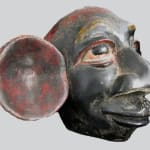Igbo Colonial Polychrome Dance Mask, 20th Century CE
Wood
16.75
PF.6240 (LSO)
Further images
This astounding polychrome mask was made by the Igbo people of Nigeria. It is remarkable in terms of its overall size and also the enormous ears that project for almost...
This astounding polychrome mask was made by the Igbo people of Nigeria. It is remarkable in terms of its overall size and also the enormous ears that project for almost as far as the face’s width on each side of the head. The eyes are bulbous, the nose large and trilobate and the mouth exceptionally side with a raised section connecting to the septum. The ground is dark, with yellowish highlights over the eyes, white dashes beneath the nose and white eyes with black pupils. The high, domed head is adorned with numerous small bored holes, presumably for holding fibrous hair. The paint indicates a post-colonial date.
The Igbo (Ibo) of the Northern Niger River Delta are one of the largest and most important tribal groups in West Africa. They are culturally highly complex, with a political system based upon a loose form of chiefdom/kingship in some areas, and a democratic panel of decision-makers in others. Their main god is Chukwu (literally “Great Spirit”), the creator of the world, who is also linked to the sun and all that grows and lives. Social conduct is governed by Ogu-na-Ofo, spirits who defend the innocent against unjust charges. If a guilty person appeals to them for help, they will be cursed by Amadioha (the god of thunder and lightning). There are numerous other gods that deal with issues as diverse as Ahia Njoku (yams) to Ikenga (fortune and industry) and Agwu (medicine men). Each person has a god named Chi, which is essentially an embodiment of a person’s fate.
The Igbo are known for their artistic diversity. Standard sculpture includes Alusi figures – large, public figures designed to embody the spirits of significant gods – and also Ikenga figures, which are kept on personal altars in private homes. Masks are usually associated with initiation ceremonies and entertainment; the powerful construction and appearance of this piece presumably had considerable resonance in the eyes of susceptible young initiates, which would justify its status as an instrument of social control.
This is a powerful and impressive piece of African art, and a worthy addition to any good collection of the genre.
The Igbo (Ibo) of the Northern Niger River Delta are one of the largest and most important tribal groups in West Africa. They are culturally highly complex, with a political system based upon a loose form of chiefdom/kingship in some areas, and a democratic panel of decision-makers in others. Their main god is Chukwu (literally “Great Spirit”), the creator of the world, who is also linked to the sun and all that grows and lives. Social conduct is governed by Ogu-na-Ofo, spirits who defend the innocent against unjust charges. If a guilty person appeals to them for help, they will be cursed by Amadioha (the god of thunder and lightning). There are numerous other gods that deal with issues as diverse as Ahia Njoku (yams) to Ikenga (fortune and industry) and Agwu (medicine men). Each person has a god named Chi, which is essentially an embodiment of a person’s fate.
The Igbo are known for their artistic diversity. Standard sculpture includes Alusi figures – large, public figures designed to embody the spirits of significant gods – and also Ikenga figures, which are kept on personal altars in private homes. Masks are usually associated with initiation ceremonies and entertainment; the powerful construction and appearance of this piece presumably had considerable resonance in the eyes of susceptible young initiates, which would justify its status as an instrument of social control.
This is a powerful and impressive piece of African art, and a worthy addition to any good collection of the genre.







